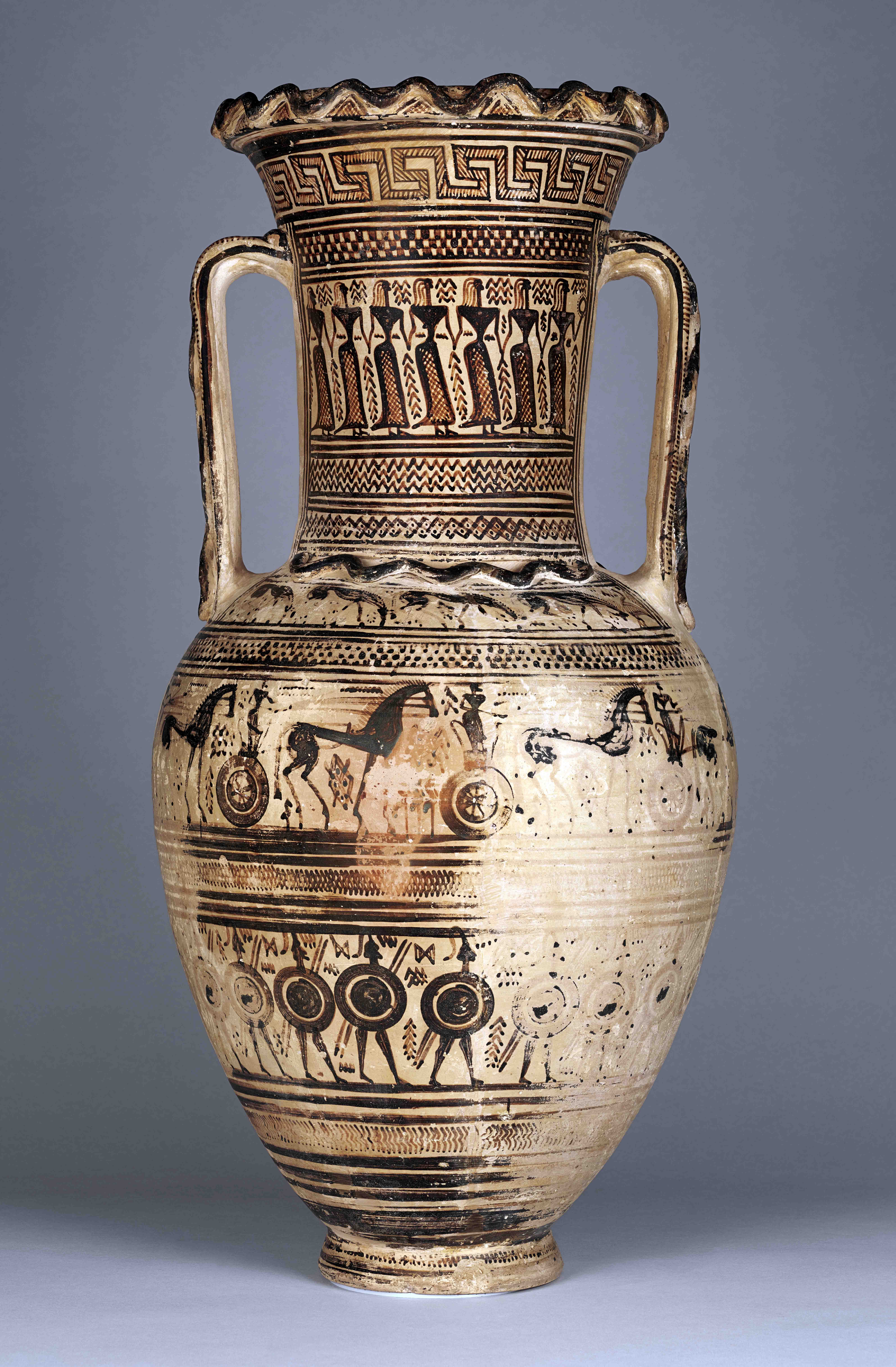
On the neck of this vase, dancing women follow a woman holding a wreath, while processions of men in chariots and armed soldiers decorate the body below. Funerary Amphora with Scenes of Mourning, 720–700 B.C., Greek, made in Athens. Terracotta, 27 5/8 x 12 in. The J. Paul Getty Museum, 2016.35. Purchased in part with funds provided by the Villa Council. Digital image courtesy of the Getty’s Open Content Program
Not unlike today, planning a funeral in ancient Greece could be a lengthy and complicated process. The relatives of the deceased arranged elaborate funerary rites to lament, honor, and celebrate the dead, along with setting up a commemorative monument to mark the burial plot.
Painted scenes on two large Athenian vases now on display in the newly reinstalled Getty Villa—including an exceptional new acquisition on view for the first time—highlight the main events of a traditional Greek funeral.
Standard representations of funeral practices on pottery in the Greek Geometric period (about 900–700 B.C.) depict events that likely occurred in real life. They illustrate the practical steps a family would take to properly care for the dead and guarantee the transition between death and the afterlife.
Step One: The Prothesis
The first step was the prothesis, or laying out of the body, usually within the home. In Greece, women played a central role in this rite. They washed and dressed the body, anointed it with oil, and arranged it on a bier or bed. The bier was usually covered with pillows and blankets, evoking an association between sleep and death. During this vigil, relatives and friends came to mourn the deceased and pay their respects.
In the main scene on the body of one vase, the corpse rests on a high bier, while men and women stand on either side, raising their hands in gestures of lamentation. One individual reaches out to touch the foot of the bier, while another kneels at the head. Two additional figures kneel below. Grieving women decorate the neck of the vase, emphasizing the sorrowful nature of the event.
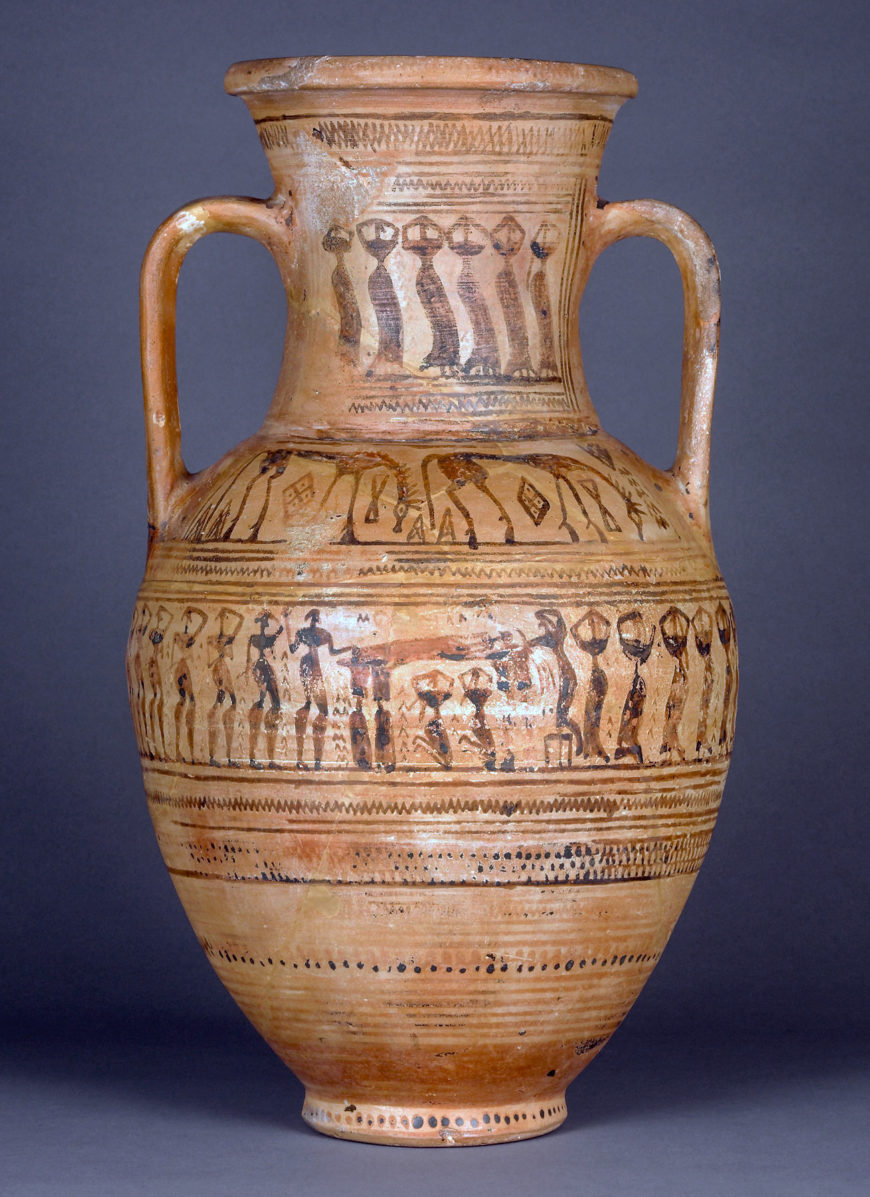
In the main scene on this vessel, the body of the deceased lies on a high bed with male and female mourners on either side. Another row of grieving woman decorates the neck of the vase above. Funerary Vessel, 710–700 B.C., Greek, made in Athens. Lent from the Rabin Collection, VL.2010.22
Step Two: The Ekphora
Following the prothesis, the mourners carried the deceased to the cemetery in a funeral procession, the ekphora, which usually took place just before dawn. They transported the body by chariot, cart, or on foot—the equivalent of our modern-day automobile cavalcade. Musicians and performers often accompanied this public display, as we see on the neck of the Getty’s newly acquired vase.
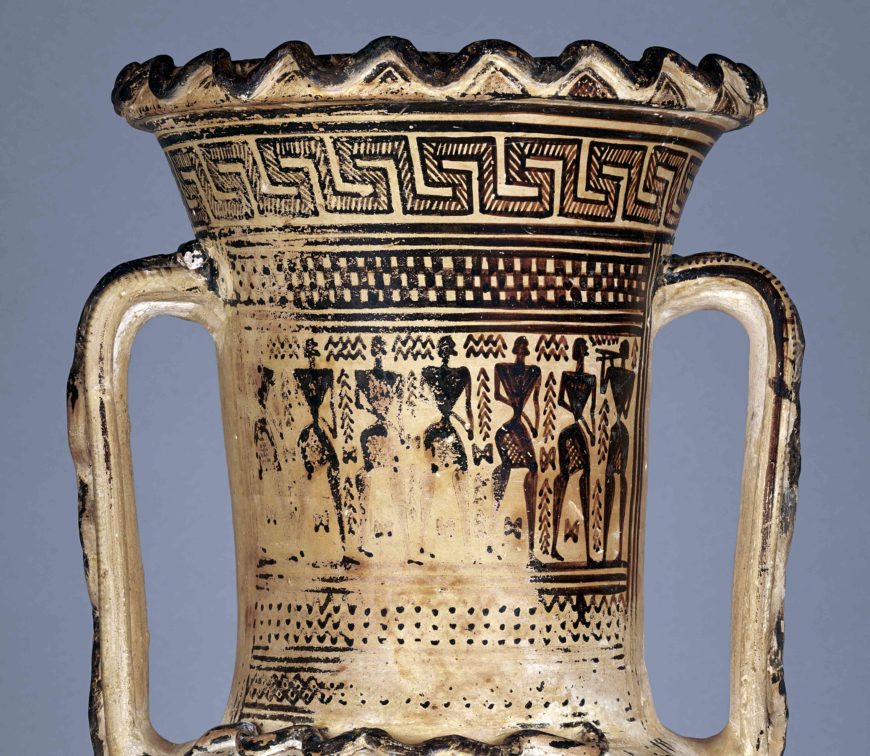
Detail of Funerary Amphora with Scenes of Mourning showing men following an aulos player in the funerary procession.
A group of men follow the music of an aulos (flute) player, while on the opposite side a woman holding a wreath leads a row of women dancing hand in hand. Snakes, traditionally associated with death, slither across the handles, shoulder, and rim of the vase. The scenes below of men in horse-drawn chariots and armed soldiers may represent ceremonial processions or funerary games held in honor of the deceased.
Step Three: Internment
The vases themselves marked the final step, the interment of the corpse. Both vessels originally served as grave markers in a cemetery. Their large size and decorative themes reveal their function as funerary monuments. But not everyone could afford such finely decorated vases. Wealthy families placed these more elaborate vessels at grave sites as a sign of their elite status in the community.
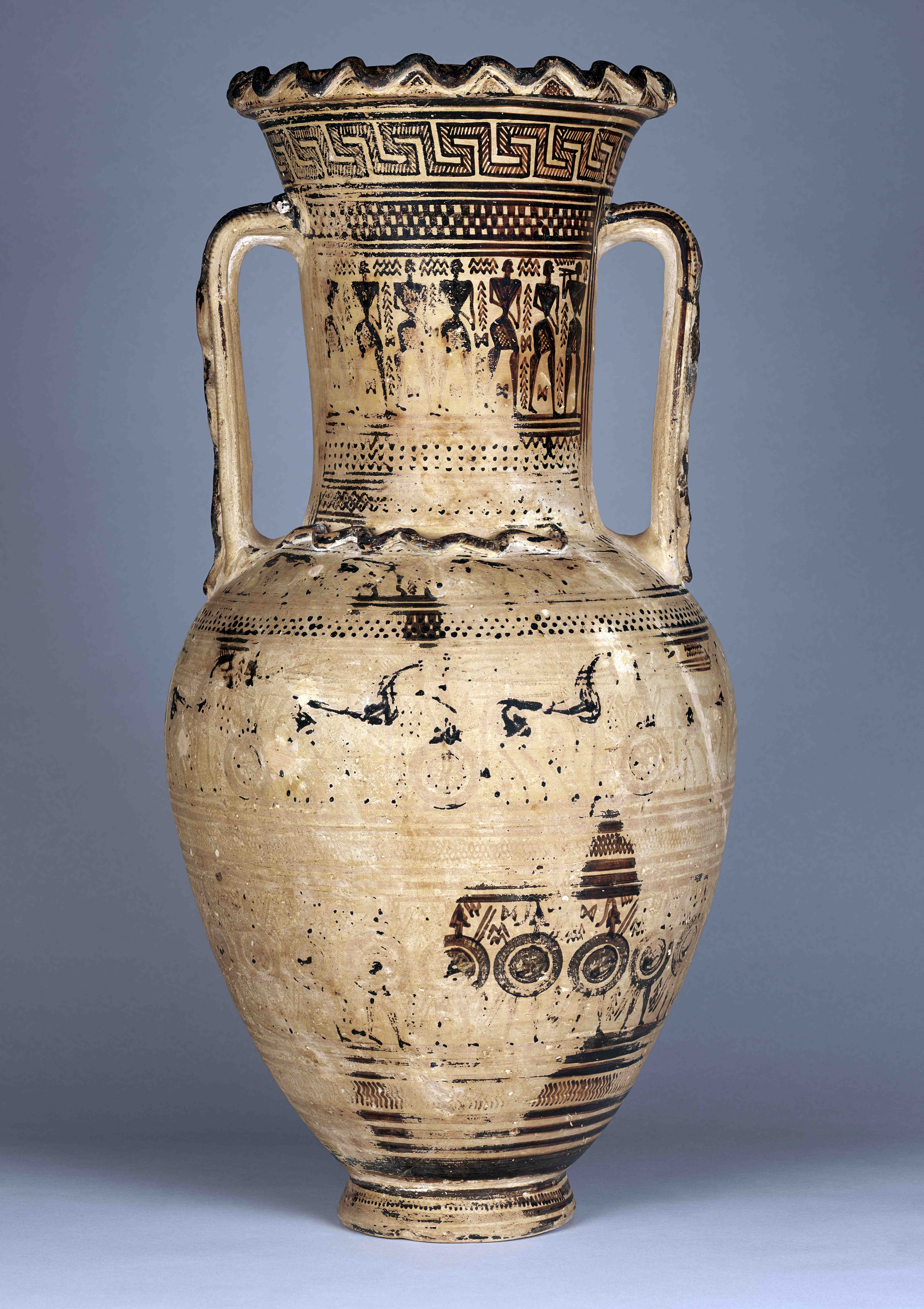
Funerary Amphora with Scenes of Mourning, 720–700 B.C., Greek, made in Athens. Terracotta, 27 5/8 x 12 in. The J. Paul Getty Museum, 2016.35. Purchased in part with funds provided by the Villa Council. Digital image courtesy of the Getty’s Open Content Program
The most common decorative motifs—chariots, warriors, and horses—likely symbolized the heroic world of aristocratic warriors and their equipment. Battles and ceremonies for the dead are recurring themes in Homer’s epic poems, the Iliad and the Odyssey, which were written down for the first time in the Geometric period.
Step Four: Commemoration
The ancient Greeks believed that the moment the psyche (soul) departs the body is only the beginning of death. Each event detailed on the vases on display at the Getty Villa marked a necessary stage in the passage to the afterlife. To join the dead required the execution of all these steps; after all, Hades only accepts to the Underworld those whose deaths are complete.
The funerary scenes that decorate these monuments therefore commemorate the entire process, not just the individual who died. Although the decoration anticipates later interest in human figures, representations of the deceased in Geometric art rarely show personalized features other than gender.
An Alternative Way to Memorialize
This attitude toward remembering the dead contrasts considerably with Archaic (700–480 B.C.) and Classical Greek (480–323 B.C.) stone grave monuments, which not only picture the deceased with individualized traits but often identify them by name.
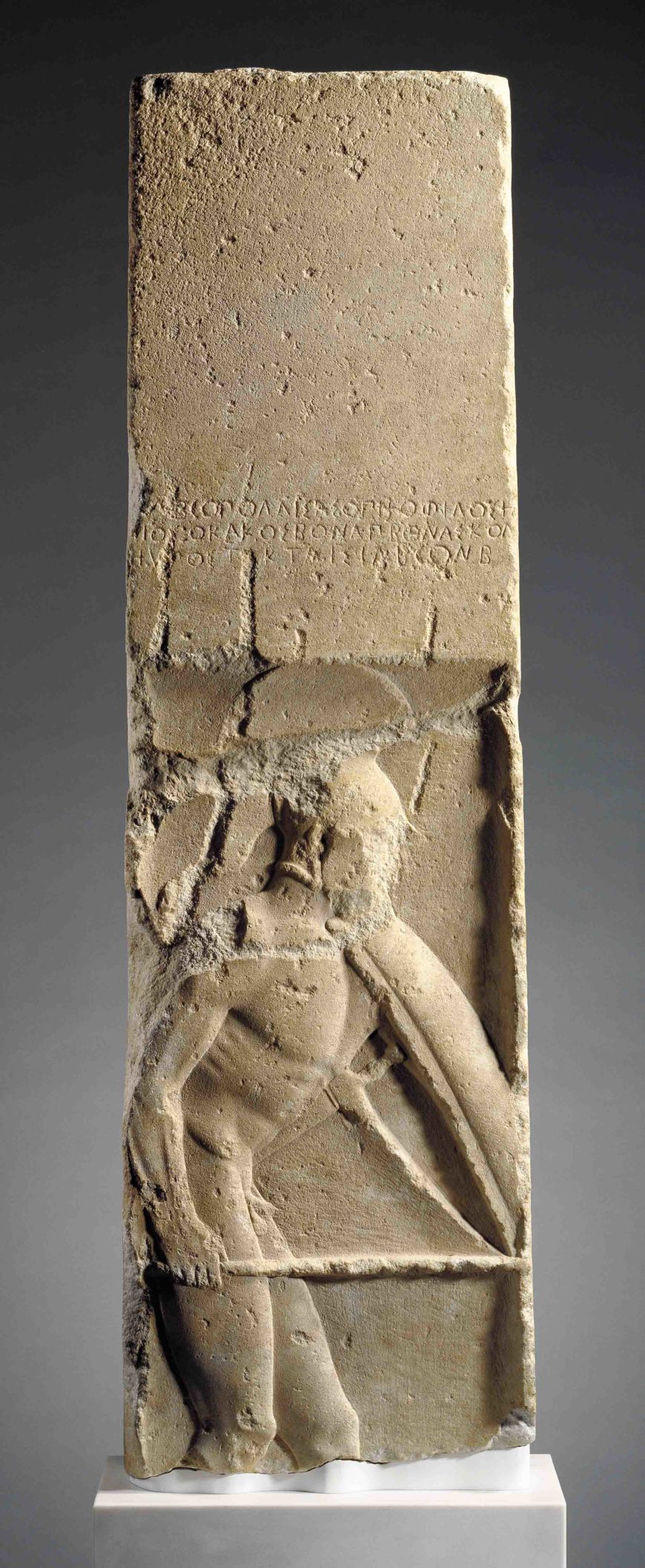
Gravestone of Pollis, about 480 B.C., Greek, made in Megara. Parian marble, 60 ¼ in. high. The J. Paul Getty Museum, 90.AA.129. Digital image courtesy of the Getty’s Open Content Program
In one fifth-century B.C. stele also on display at the Villa, a helmeted warrior advances into battle with his shield raised and spear ready. The Greek inscription above identifies him as Pollis, son of Asopichos, who perished at the hands of the “tattooers.” The tattooed enemies referred to in the epitaph were the Thracians, a tribe from the north that fought on the side of the Persian invaders in the war of 480–479 B.C. Although the Greeks were victorious, Pollis lost his life. The grave monument commemorates not only Pollis but also his death as a fallen warrior.
All these monuments illustrate how the Greeks commemorated the dead. They confirmed that the deceased had successfully transitioned to the underworld and preserved their memory for future generations. The link between the realms of the living and dead were entwined even in life. The two vases were made in the main cemetery in ancient Athens, the Kerameikos—named from the Greek word for pottery—which lay just outside the city gate. [1] When approaching Athens, therefore, a visitor had to first walk through a veritable city of the dead.
Essay first appeared in the iris.
Notes:
[1] In this case, the original text should read that the vases were not made in the cemetery, but were made in the Potter’s Quarter of the area called the Kerameikos.

